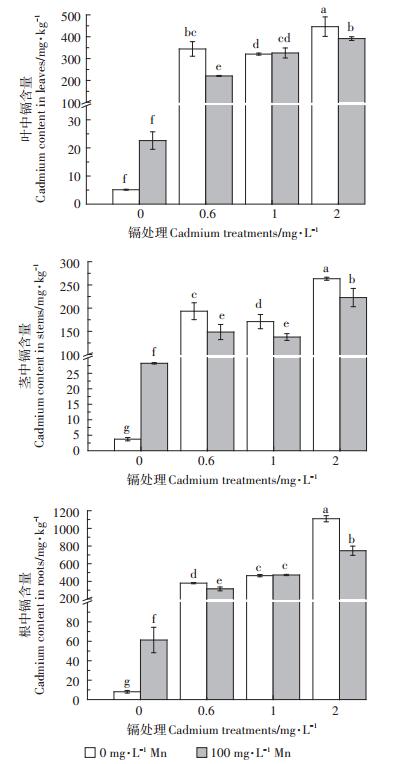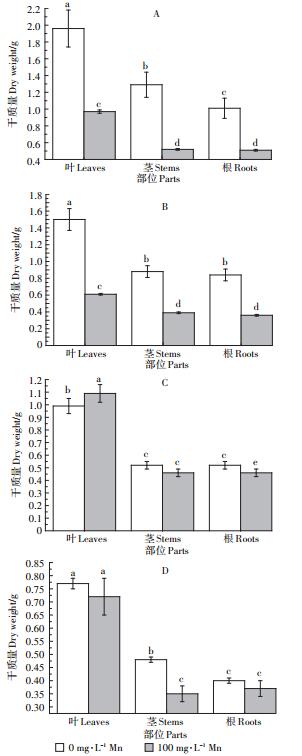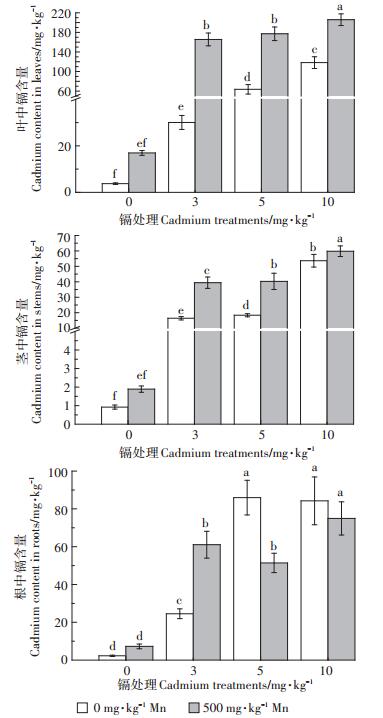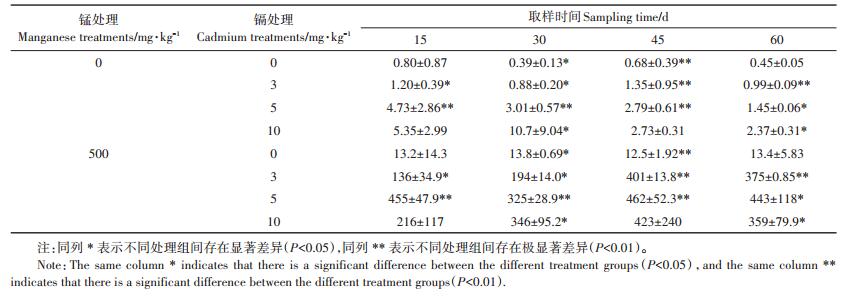镉是土壤中最为普遍的重金属污染物之一,易通过食物链在人体内积累,进而危害人类健康[1-3]。由于镉是典型的亲石元素,常见于钙、锰的氧化矿物中,导致单一镉污染土壤较少,在镉污染土壤中镉常与锰等其他重金属复合存在[4-5]。因此,在进行土壤镉修复时需考虑镉与锰的相互作用[6-8]。
目前,关于锰对植物吸收和利用镉的影响已有诸多研究。前人研究结果表明,在小麦和油菜中,施加高量的锰促进了植物对镉的积累[9-10]。在超富集植物Phytolacca americana L.和水稻中,施加锰则缓解了镉的毒性,降低了植物对镉的吸收和积累[11-12],但在土培条件下,施加锰则显著增加水稻对镉的积累[13]。以上矛盾的结果表明,锰在超富集植物吸收和积累镉时的影响仍有很多的不确定性。另外,在统一试验条件下同时进行水培试验与土培试验来探究锰对植物吸收和积累镉的影响的研究相对较少,并且在水培试验中采取了与实际土壤溶液中镉含量差别较大的浓度[14-16]。
青葙(Celosia argentea Linn.)是一种新发现的锰、镉超富集植物,能够同时吸收和积累大量的镉和锰[17]。为研究植物吸收镉和锰的相互作用规律提供了理想的实验材料。本研究采用水培与土培两种方式研究了锰对青葙吸收和积累镉的影响,同时通过动态监测手段,研究了锰对土壤溶液中镉浓度的影响,为阐明植物吸收镉锰的作用关系奠定基础,为镉锰复合污染土壤的植物修复提供理论依据。
1 材料与方法 1.1 土培试验本试验在桂林理工大学重金属污染植物修复试验基地进行。供试土壤采自桂林理工大学雁山校区。土壤采集后,置于阴凉处风干。土壤pH、有机质、有效氮、速效磷与速效钾等基本理化性质采用土壤检测仪(SL-3A)进行测定,结果见表 1。供试土壤总Mn与总Cd利用HNO3-HClO4-HF消解法进行消解,消解后采用原子吸收光谱仪(PE-AA700型)进行测定。青葙种子采集于广西壮族自治区桂林市阳朔县。将青葙种子采用1%的H2O2溶液浸泡消毒后,选取颗粒饱满的种子播种于规格为4×8的育苗盘中,置于温室中培养并且保持温室温度在25~30 ℃。种子萌发后每周浇灌1/2浓度的Hongland营养液1次,并保持育苗盘内的土壤含水量为田间最大持水量的70%~80%。待幼苗长出4~6片真叶且高度为5~6 cm时,移栽幼苗进行土培盆栽试验。
|
|
表 1 供试土壤理化性质 Table 1 Soil physical and chemical properties |
土壤风干过筛后,取1.5 kg装入直径12 cm,高18 cm的塑料盆中。重金属锰和镉以MnCl2·4H2O和CdCl2·2.5H2O的固态粉末形式加入盆中与土壤混合均匀,配制成锰浓度为0(对照)、500 mg·kg-1和镉浓度为0(对照)、3、5 mg·kg-1和10 mg·kg-1的土样,每个处理3个重复。调节盆栽土壤含水量为田间最大持水量的70%~80%,每日翻动土壤,平衡2周后移栽长势基本一致的青葙幼苗并同时埋入土壤溶液取样器,每隔15 d抽取一次土壤溶液,每次抽取10 mL,植物生长60 d后收获。
1.2 水培试验该试验在桂林理工大学重金属污染植物修复试验基地进行。青葙种子采集及发芽同土培试验,待幼苗长至约5~6 cm高、4~6片真叶时挑选生长一致的幼苗分别栽进装有1/2 Hoagland营养液的塑料烧杯中,重金属锰和镉以MnCl2·4H2O和CdCl2·2.5H2O的固态粉末形式加入营养液中混合均匀,配制成锰浓度为0(对照)、100 mg·L-1和镉浓度为0(对照)、0.6、1.0 mg·L-1和2.0 mg·L-1的水溶液,每个处理3次重复,每3 d调节1次pH并用去离子水补充蒸发部分,每3 d更换营养液一次,每日曝气20 min,置于温室中培养。植物生长45 d后收获,测定青葙根、茎、叶中锰、镉含量。
1.3 样品处理及分析青葙收获后分为叶、茎和根3部分。将青葙叶、茎和根用自来水将泥土洗净后,用去离子水冲洗3次,置于烘箱中105 ℃杀青30 min,70 ℃烘干至恒质量后用电子天平测其干质量。烘至恒质量后的叶、茎和根于植物粉碎机中粉碎,粉碎后的样品(约0.2 g)采用HNO3+HClO4(9:1)湿消化法消解,锰、镉在青葙中的含量采用原子吸收光谱仪(PE-AA700)测定。分析过程中所采用的试剂均为优级纯试剂,采用国家标准参比物质[GBW 10015(GSB-6)]进行分析质量控制。
土壤溶液采集后采用优级纯硝酸对其进行酸化,采用ICP-MS测定其镉含量。
1.4 试验数据处理试验数据采用3个重复样的算术平均值±标准偏差(SD)表示。所有数据均采用Excel 2007和Origin 8.0进行统计分析和作图,用SPSS 19.0软件中的单因素方差分析(ANOVA),用最小显著差数法(LSD)进行显著性检验(P < 0.05)。
2 结果与分析 2.1 水培条件下锰对青葙镉积累及生长情况的影响由图 1可知,在未额外添加锰的情况下,青葙叶、茎和根中的镉含量随着镉处理浓度的升高而增加,在镉处理浓度为2 mg·L-1时,青葙叶、茎和根中镉的含量最高。在镉处理浓度为1 mg·L-1时,施加锰浓度为100 mg·L-1时,青葙叶片中的镉含量较未施加锰处理组相比并无显著差异,但在青葙茎中,施加锰处理组镉含量较未施加锰处理组镉含量降低了19.1%。在镉处理浓度为0.6 mg·L-1和2 mg·L-1时,施加100 mg·L-1锰处理组青葙叶和茎中的镉含量分别比未施加锰处理组降低了35.9%、12.3%和23.2%、15.4%。由图 2可知,在未额外添加镉的情况下,青葙叶、茎和根中的锰含量在施加锰后均显著增加。在锰处理浓度为100 mg·kg-1时,青葙叶片中的锰含量除在镉处理浓度为0.6 mg·L-1时较未施加镉处理组降低17.7%外,其余处理组青葙叶片中锰含量与未施加镉处理组相比并无显著差异。在青葙茎中,锰处理浓度为100 mg·kg-1时,除在镉处理浓度为2 mg·L-1时青葙茎中镉含量较未施加镉处理组降低19.0%外,其余处理组青葙茎中锰含量与未施加镉处理组相比并无显著差异。结果表明,水培条件下外源施加锰会抑制青葙对镉的吸收和积累,且随着镉处理浓度的升高锰对于青葙累积镉的抑制作用逐渐减弱,而外源施加镉则对青葙对锰的吸收和累积并无显著影响。

|
不同字母表示处理间存在显著差异(P<0.05),下同 Different letters represent significant difference among different treatments (P<0.05), the same below 图 1 水培青葙叶、茎和根中的镉含量 Figure 1 Cadmium content in leaves, stems and roots of C. argentea in hydroponic culture experiments |

|
图 2 水培青葙叶、茎和根中的锰含量 Figure 2 Manganese content in leaves, stems and roots of C. argentea in hydroponic culture experiments |
由图 3可知,未施加锰时,青葙叶、茎和根的生物量随着镉处理浓度的升高而降低,在镉处理浓度为2 mg·L-1时青葙生物量下降最大,说明镉对青葙造成了一定的毒害作用,从而抑制了青葙的正常生长。在镉处理浓度为0.6 mg·L-1时,施加100 mg·L-1锰青葙生物量较未施加锰处理组显著降低,说明施加锰抑制了青葙的生长。在镉处理浓度为1 mg·L-1和2 mg·L-1时,施加锰处理组较未施加锰处理组相比并无显著差异,施加锰并未抑制青葙的生长。

|
A、B、C、D分别是0、0.6、1、2 mg·L-1镉处理组施加100 mg·L-1锰与未施加锰的盆栽叶、茎和根的生长情况对比 A, B, C, and D are 0, 0.6, 1, 2 mg·L-1 cadmium treatment group applied 100 mg·L-1 manganese and no manganese applied potted leaves, stems and roots growth comparison 图 3 水培试验中锰对不同浓度镉胁迫青葙叶茎根生长的影响 Figure 3 Effects of manganese on the growth of leaves, stems and roots of C. argentea under different concentrations of cadmium in hydroponic culture experiments |
由图 4可知,在未施加锰的情况下,青葙叶、茎和根中的镉含量随着镉处理浓度的增加而升高。在镉处理浓度相同水平的条件下,施加500 mg·kg-1锰青葙叶和茎中的镉含量较未施加锰相比均显著增加。相较于未施加锰处理组,施加锰青葙叶和茎的镉含量分别增加了351.7%、451.0%、178.2%、74.2%和105.4%、140.2%、119.4%、11.5%,且镉处理浓度为3 mg·kg-1时施加500 mg·kg-1锰青葙茎和叶中的镉含量增加最多。由图 5可知,在未施加镉的情况下,青葙叶、茎和根中的锰含量较未施加锰前相比均显著增加。在锰处理浓度为500 mg·kg-1时,施加镉处理组青葙叶和茎的锰含量均较未施加镉处理组显著增加,分别增加了117.2%、61.1%、78.0%和69.6%、39.7%、31.4%,在镉处理为3 mg·kg-1时,青葙叶和茎的锰含量最高。由此可见,在土培条件下施加锰和镉可以显著促进青葙对镉和锰的吸收和积累。

|
图 4 土培青葙叶、茎和根中镉含量 Figure 4 Cadmium content in leaves, stems and roots of C. argentea in soil culture experiments |

|
图 5 土培青葙叶、茎和根中锰含量 Figure 5 Manganese content in leaves, stems and roots of C. argentea in soil culture experiments |
由表 2可知,镉在土壤中从固相到液相的释放是一个缓慢而持续的过程。未施加锰处理组中,土壤溶液中镉的含量相对于外源所添加的镉含量而言极低。施加锰处理组与未施加锰处理组相比,土壤溶液中镉含量显著增加,且增加量在镉处理浓度为3 mg·kg-1时最高。由此可见,施加锰可显著促进镉向土壤溶液中的释放。
|
|
表 2 土壤溶液中镉含量(μg·L-1) Table 2 Cadmium content in soil solution(μg·L-1) |
由图 6a可知,青葙生物量随着镉处理浓度的增加而降低,说明镉对青葙产生了一定的毒害作用从而抑制了青葙的生长。在镉处理浓度为3、5 mg·kg-1和10 mg·kg-1时,施加锰青葙生物量较未施加锰相比显著增加,分别较未施加锰处理组增加了91.3%、31.1%和44.0%,且在镉处理浓度为3 mg·kg-1时施加锰青葙生物量增加最多。由图 6b可知,收获时青葙生长良好,在镉处理相同水平下,施加锰青葙株高均高于未施加锰的处理组。本试验结果说明,在土培条件下青葙受到镉胁迫时施加锰可缓解镉对青葙的毒性。

|
图 6 土培试验中锰对不同浓度镉胁迫青葙叶、茎、根生长的影响 Figure 6 Effects of manganese on the growth of leaves, stems and roots of C. argentea under different mass fraction of cadmium in hydroponic culture experiments |
通过水培试验和土培试验的结果可以看出,锰在水培试验和土培试验中对青葙吸收和累积镉的作用不同。在水培试验中,向营养液中施加锰抑制了青葙对镉的吸收和累积。而在土培试验中,施加锰显著促进了青葙对于镉的吸收和累积,该结果与前人研究结果不一致,前人研究认为施加锰降低植物对镉的吸收和累积[18-19]。
前期研究表明,青葙也是一种锰的超富集植物[20]。在本试验中,施加高浓度的锰后,青葙仍可对镉进行累积,其原因可能是与锰和镉在青葙体内的分布情况及其转运蛋白有关[21-24]。在水培试验中,外源添加的锰、镉含量远远高于土壤溶液中锰、镉的实际含量,且土壤溶液中镉的释放是一个缓慢且持续的过程,而在水培试验中镉的施加则是随着每次更换营养液一次性施加,无法做到与土壤溶液中的镉一样保持动态平衡。前人研究认为,锰和镉在植物体内可能享有相同的转运蛋白,如ZIP家族、NRAMP家族、CDF家族和CPx-ATPase家族等[25-26]。前人研究表明,在东南景天中锰和镉通过ZIP家族转运[27],在芥菜中锰和镉通过HMA4转运[28],在大麦中通过HvIRT1转运[29],且重金属在被植物吸收过程中可能竞争相同的转运蛋白,存在竞争性抑制的关系[30]。在水培试验中,施加镉对青葙锰的累积并无显著影响,但锰的施加却显著抑制了青葙对镉的积累。其原因可能是青葙吸收和转运锰和镉这两种离子的过程中,锰离子与镉离子同时竞争在青葙体内的转运蛋白,且锰离子与转运蛋白的结合能力高于镉离子,从而导致青葙对镉离子转运数量的减少。
在土培试验中,由于土壤溶液中的锰离子和镉离子浓度显著低于水培试验中的锰离子和镉离子浓度,二者在溶液中由于金属离子的拮抗作用缓解了这两种离子本身对植物的毒害作用,所以土壤溶液中锰离子和镉离子共存的浓度并未对青葙根系造成显著的毒害作用。另外,前人研究发现,外源施加在土壤中较高浓度的锌显著抑制了镉在土壤中的吸附,从而降低了土壤胶体对镉的吸附量,进而导致水溶态镉含量的增加[31-34]。由此可推断,在土培试验中向施加镉的土壤中外源添加锰,锰与镉在土壤溶液中竞争与土壤胶体的吸附位点,由于锰的添加量显著高于镉的添加量,所以施加锰可显著降低土壤胶体对镉的吸附,从而促进镉从固相到液相的转移,导致土壤溶液中水溶态镉含量显著增加,进而导致施加锰后青葙镉含量的升高。另外,由于锰是植物生长所必需的营养元素[35-36],能够提高植物生长发育速度、净光合速率及蒸腾量[37-38]。因此在土培盆栽试验中,施加锰提高了青葙的叶面积,使青葙的蒸腾量增加,有助于镉随蒸腾流向上转运,从而促进了青葙对镉的积累。所以,水培试验与土培试验的结果矛盾。
4 结论(1)施加锰能够显著影响镉在青葙中的吸收与累积,其效果在水培试验和土培试验中存在明显差异。在水培试验中,施加锰抑制了青葙对镉的吸收和累积。而在土培试验中,锰的施加促进了青葙对镉的吸收。
(2)虽然锰和镉在青葙中可能存在相同的转运及富集机制,但由于锰和镉在土壤中存在离子交换作用,从而导致锰在水培试验与土培试验中对青葙吸收与累积镉的作用相反。
(3)外源添加的镉在土壤中转化为可供植物吸收的水溶态含量极低,且锰的施加促进了镉在土壤中从固相到液相的释放。
| [1] |
环境保护部, 国土资源部. 全国土壤污染状况调查公报[J]. 中国环保产业, 2014, 36(5): 1689-1692. Ministry of Environmental Protection, Ministry of Land and Resources. National soil pollution status survey bulletin[J]. China′s Environmental Protection Industry, 2014, 36(5): 1689-1692. |
| [2] |
苗亚琼, 林清. 广西土壤重金属镉污染及对人体健康的危害[J]. 环境与可持续发展, 2016, 41(5): 171-173. MIAO Ya-qiong, LIN Qing. Pollution Caused by heavy metal cadmium to the soil in Guangxi and its harm to human health[J]. Journal of Environment and Sustainable Development, 2016, 41(5): 171-173. DOI:10.3969/j.issn.1673-288X.2016.05.046 |
| [3] |
Uraguchi S, Fujiwara T. Rice breaks ground for cadmium-free cereals.[J]. Current Opinion in Plant Biology, 2013, 16(3): 328-337. DOI:10.1016/j.pbi.2013.03.012 |
| [4] |
赵峰, 谌斌, 李明顺. 锰及锰镉复合污染对锰矿区茶园土壤酶活性的影响[J]. 广西师范大学学报(自然科学版), 2008, 26(4): 128-131. ZHAO Feng, CHEN Bin, LI Ming-shun. Effect of Mn and Mn-Cd combined pollution on soil enzymatic activities in tea garden of manganese mineland[J]. Journal of Guangxi Normal University:Natural Science Edition, 2008, 26(4): 128-131. DOI:10.3969/j.issn.1001-6600.2008.04.032 |
| [5] |
唐文杰, 邓华, 李蘅, 等. 八一锰矿恢复区(茶园)土壤重金属污染特征研究[J]. 湖北农业科学, 2016, 55(4): 855-858. TANG Wen-jie, DENG Hua, LI Heng, et al. Contamination characteristics of soil heavy metals in Bayi Mn mine on restored area (tea garden)[J]. Hubei Agricultural Sciences, 2016, 55(4): 855-858. |
| [6] |
莫斌吉, 雷良奇, 张能, 等. 广西大厂碳酸盐型硫化物尾矿中镉的地球化学行为[J]. 矿物岩石地球化学通报, 2015, 34(5): 1050-1057. MO Bin-ji, LEI Liang-qi, ZHANG Neng, et al. Cadmium ′ s geochemical behaviors in carbonate sulfide tailings in Dachang, Guangxi[J]. Bulletin of Mineralogy, Petrology and Geochemistry, 2015, 34(5): 1050-1057. DOI:10.3969/j.issn.1007-2802.2015.05.022 |
| [7] |
赖燕平, 李明顺, 杨胜香, 等. 广西锰矿恢复区食用农作物重金属污染评价[J]. 应用生态学报, 2007, 18(8): 1801-1806. LAI Yan-ping, LI Ming-shun, YANG Sheng-xiang, et al. Evaluation of heavy metal pollution of edible crops in Guangxi manganese mine recovery area[J]. Chinese Journal of Applied Ecology, 2007, 18(8): 1801-1806. |
| [8] |
李航, 肖唐付, 何立斌, 等. 镉的表生环境地球化学效应[J]. 矿物岩石地球化学通报, 2006, 25(增刊1): 84-86. LI Hang, XIAO Tang-fu, HE Li-bin, et al. Epigenetic environmental geochemical effects of cadmium[J]. Mineral Rock Geochemistry Bulletin, 2006, 25(Suppl 1): 84-86. |
| [9] |
周相玉, 冯文强, 秦鱼生, 等. 镁、锰、活性炭和石灰及其交互作用对小麦镉吸收的影响[J]. 生态学报, 2013, 33(14): 4289-4296. ZHOU Xiang-yu, FENG Wen-qiang, QIN Yu-sheng, et al. Effects of magnesium, manganese, activated carbon and lime and their interaction on cadmium uptake in wheat[J]. Acta Ecologica Sinica, 2013, 33(14): 4289-4296. |
| [10] |
李然, 徐应明, 王林, 等. 不同锰处理对镉胁迫下2种油菜重金属累积和根系形态的影响[J]. 生态毒理学报, 2018(2): 140-148. LI Ran, XU Ying-ming, WANG Lin, et al. Effects of different manganese treatments on heavy metals accumulation and root morphology of two cultivars of Brassica chinensis under cadmium stress[J]. Asian Journal of Ecotoxicology, 2018(2): 140-148. |
| [11] |
Peng K, Luo C, You W, et al. Manganese up take and interactions with cadmium in the hyperaccumulator-Phytolacca americana L.[J]. Journal of Hazardous Materials, 2008, 154: 674-681. DOI:10.1016/j.jhazmat.2007.10.080 |
| [12] |
徐莜, 杨益新, 李文华, 等. 锰离子浓度及其转运通道对水稻幼苗镉吸收转运特性的影响[J]. 农业环境科学学报, 2016, 35(8): 1429-1435. XU You, YANG Yi-xin, LI Wen-hua, et al. Effects of manganese concentrations and transporters on uptake and translocation of cadmium in rice seedlings[J]. Journal of Agro-Environment Science, 2016, 35(8): 1429-1435. |
| [13] |
Huang Q N, An H, Yang Y J, et al. Effects of Mn-Cd antagonistic interaction on Cd accumulation and major agronomic traits in rice genotypes by different Mn forms[J]. Plant Growth Regulation, 2017, 82(2): 1-15. |
| [14] |
蔡春婷, 汤克丽, 许旭萍, 等. 镉铅复合胁迫下根表铁锰氧化胶膜厚度对美洲商陆富集镉的影响[J]. 环境科学学报, 2017, 37(1): 298-307. CAI Chun-ting, TANG Ke-li, XU Xu-ping, et al. Effects of iron-manganese plaque thickness on Cd accumulation in Phytolacca americana under Cd-Pb combined stress[J]. Journal of Environmental Sciences, 2017, 37(1): 298-307. |
| [15] |
余保文, 朱诚. 丁草胺对镉胁迫条件下水稻生长、镉积累及活性氧代谢的影响[J]. 环境科学学报, 2008, 28(9): 1878-1886. YU Bao-wen, ZHU Cheng. Effects of butachlor on the growth, cadmium accumulation and oxidative metabolism of rice under Cd2+ stress[J]. Environmental Science & Pollution Research, 2008, 28(9): 1878-1886. DOI:10.3321/j.issn:0253-2468.2008.09.025 |
| [16] |
Hu P, Yin Y G, Ishikawa S, et al. Nitrate facilitates cadmium uptake, transport and accumulation in the hyperaccumulator Sedum plumbizincicola[J]. Environmental Science & Pollution Research, 2013, 20(9): 6306-6316. |
| [17] |
Liu J, Mo L, Zhang X, et al. Simulaneous hyperaccumulation of cadmium and manganese in Celosia argentea Linn[J]. International Journal of Phytoremediation, 2018. DOI:10.1080/15226514.2017.1365341 |
| [18] |
Liu H, Zhang Y, Chai T, et al. Manganese-mitigation of cadmium toxicity to seedling growth of Phytolacca acinosa, Roxb. is controlled by the manganese / cadmium molar ratio under hydroponic conditions[J]. Plant Physiology & Biochemistry, 2013, 73(6): 144-153. |
| [19] |
Zornoza P, Sánchez-Pardo B, Carpena R O. Interaction and accumulation of manganese and cadmium in the manganese accumulator Lupinus albus[J]. Journal of Plant Physiology, 2010, 167(13): 1027-1032. DOI:10.1016/j.jplph.2010.02.011 |
| [20] |
余轲, 刘杰, 尚伟伟, 等. 青葙对土壤锰的耐性和富集特征[J]. 生态学报, 2015, 35(16): 5430-5436. YU Ke, LIU Jie, SHANG Wei-wei, et al. Tolerance and accumulation characteristics of Celosia argentea Linn. growing in Mn-contaminated soil[J]. Acta Ecologica Sinica, 2015, 35(16): 5430-5436. |
| [21] |
Fernando D R, Mizuno T, Woodrow I E, et al. Characterization of foliar manganese (Mn) in Mn (hyper) accumulators using X-ray absorption spectroscopy[J]. New Phytologist, 2010, 188(4): 1014-1027. DOI:10.1111/j.1469-8137.2010.03431.x |
| [22] |
Fernando D R, Woodrow I E, Baker A J, et al. Plant homeostasis of foliar manganese sinks:Specific variation in hyperaccumulators[J]. Planta, 2012, 236(5): 1459-1470. DOI:10.1007/s00425-012-1699-6 |
| [23] |
Lombi E, Tearall K L, Howarth J R, et al. Influence of iron status on cadmium and zinc uptake by different ecotypes of the hyperaccumulator Thlaspi caerulescens[J]. Plant Physiology, 2002, 128(4): 1359-1367. DOI:10.1104/pp.010731 |
| [24] |
Thomine S, Wang R, Ward J M, et al. Cadmium and iron transport by members of a plant metal transporter family in Arabidopsis with homology to Nramp genes[J]. Proceedings of the National Academy of Sciences of the United States of America, 2000, 97(9): 4991-4996. DOI:10.1073/pnas.97.9.4991 |
| [25] |
David F Garvin, Leon V Kochian. The role of iron-deficiency stress responses in stimulating heavy-metal transport in plants[J]. Plant Physiology, 1998, 116(3): 1063-1072. |
| [26] |
Sasaki A, Yamaji N, Yokosho K, et al. Nramp5 is a major transporter responsible for manganese and cadmium uptake in rice[J]. Plant Cell, 2012, 24(5): 2155-2167. DOI:10.1105/tpc.112.096925 |
| [27] |
高峻.超积累东南景天转录组学分析与ZIP家族基因功能研究[D].杭州: 浙江大学, 2013. GAO Jun. Transcriptional analysis of hyperaccumulating Sedum alfredii Hance and functional study of ZIP family genes[D]. Hangzhou: Zhejiang University, 2013. http://med.wanfangdata.com.cn/Paper/Detail?id=DegreePaper_Y2405204 |
| [28] |
陈艳芳, 李取生, 何宝燕, 等. 高/低Cd累积苋菜品种金属累积特性与关键转运基因表达的关系[J]. 农业环境科学学报, 2015, 34(6): 1041-1046. CHEN Yan-fang, LI Qu-sheng, HE Bao-yan, et al. Metal accumulation and expressions of root two key transporter genes, HMA4 and IRT1, of high/low Cd-accumulating amaranth cultivars[J]. Journal of Agro-Environment Science, 2015, 34(6): 1041-1046. |
| [29] |
Pedas P, Ytting C K, Fuglsang A T, et al. Manganese efficiency in barley: Identification and characterization of the metal ion transporter HvIRT1[J]. Plant Physiology, 2008, 148(1): 455-466. |
| [30] |
Hart J J, Welch R M, Norvell W A, et al. Transport interactions between cadmium and zinc in roots of bread and durum wheat seedlings[J]. Physiol Plant, 2010, 116(1): 73-78. |
| [31] |
曹勤英, 黄志宏. 污染土壤重金属形态分析及其影响因素研究进展[J]. 生态科学, 2017, 36(6): 222-232. CAO Qin-ying, HUANG Zhi-hong. Review on speciation analysis of heavy metals in polluted soils and its influencing factors[J]. Ecological Science, 2017, 36(6): 222-232. |
| [32] |
孟昭福, 万丹, 邓晶, 等. Cu2+、Zn2+复合条件下Cd2+在陕西5种土壤中的吸附[J]. 农业环境科学学报, 2011, 30(1): 71-77. MENG Zhao-fu, WAN Dan, DENG Jing, et al. Adsorption of Cd2+ with Cu2+, Zn2+ coexistence in soils of Shaanxi, China[J]. Journal of Agro-Environment Science, 2011, 30(1): 71-77. |
| [33] |
李玉萍, 刘晓端, 宫辉力. 土壤中铅铜锌镉的吸附特性[J]. 岩矿测试, 2007, 26(6): 455-459. LI Yu-ping, LIU Xiao-duan, GONG Hui-li. Adsorption characteristics of lead, copper, zinc and cadmium in soil[J]. Rock and Mineral Analysis, 2007, 26(6): 455-459. DOI:10.3969/j.issn.0254-5357.2007.06.006 |
| [34] |
白瑛. 胶体吸附与土壤重金属容量[J]. 农业环境保护, 1986(2): 25-28, 17. BAI Ying. Colloid adsorption and soil heavy metal capacity[J]. AgroEnvironmental Protection, 1986(2): 25-28, 17. |
| [35] |
Possingham J V, Spencer D. Manganese as a functional component of chloroplasts[J]. Australian Journal of Biological Sciences, 1962, 15(1): 58-68. |
| [36] |
Teichler-Zallen D. The effect of manganese on chloroplast structure and photosynthetic ability of Chlamydomonas reinhardi[J]. Plant Physiology, 1969, 44(5): 701-710. DOI:10.1104/pp.44.5.701 |
| [37] |
Karl H Schütte. Micro-nutrient deficiency and transpiration in Tropaeolum majus L.[J]. Journal of Experimental Botany, 1959, 10(3): 443-447. DOI:10.1093/jxb/10.3.443 |
| [38] |
孟祥萍, 李春霞, 国海燕, 等. 锰素浸种对小麦幼苗光合特性及其根系形态与活力的影响[J]. 西北植物学报, 2016, 36(4): 745-750. MENG Xiang-ping, LI Chun-xia, GUO Hai-yan, et al. Effects of manganese soaking on wheat seedling photosynthetic characteristics and root system, root vigor[J]. Acta Botanica Boreali-Occidentalia Sinica, 2016, 36(4): 745-750. |
 2019, Vol. 38
2019, Vol. 38




